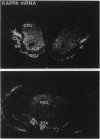Abstract
A full-length cDNA was isolated from a rat striatal library by using low-stringency screening with two PCR fragments, one spanning transmembrane domains 3-6 of the mouse delta opioid receptor and the other unidentified but homologous to the mouse delta receptor from rat brain. The novel cDNA had a long open reading frame encoding a protein of 380 residues with 59% identity to the mouse delta receptor and topography consistent with a seven-helix guanine nucleotide-binding protein-coupled receptor. COS-1 cells transfected with the coding region of this clone showed high-affinity binding to kappa opioid receptor-selective ligands such as dynorphin A and U-50,488 and also nonselective opioid ligands such as bremazocine, ethylketocyclazocine, and naloxone. Not bound at all (or bound with low affinity) were dynorphin A-(2-13), enantiomers of naloxone and levophanol [i.e., (+)-naloxone and dextrorphan], and selective mu and delta opioid receptor ligands. Activation of the expressed receptor by kappa receptor agonists led to inhibition of cAMP. Finally, in situ hybridization revealed a mRNA distribution in rat brain that corresponded well to the distribution of binding sites labeled with kappa-selective ligands. These observations indicate that we have cloned a cDNA encoding a rat kappa receptor of the kappa 1 subtype.
Full text
PDF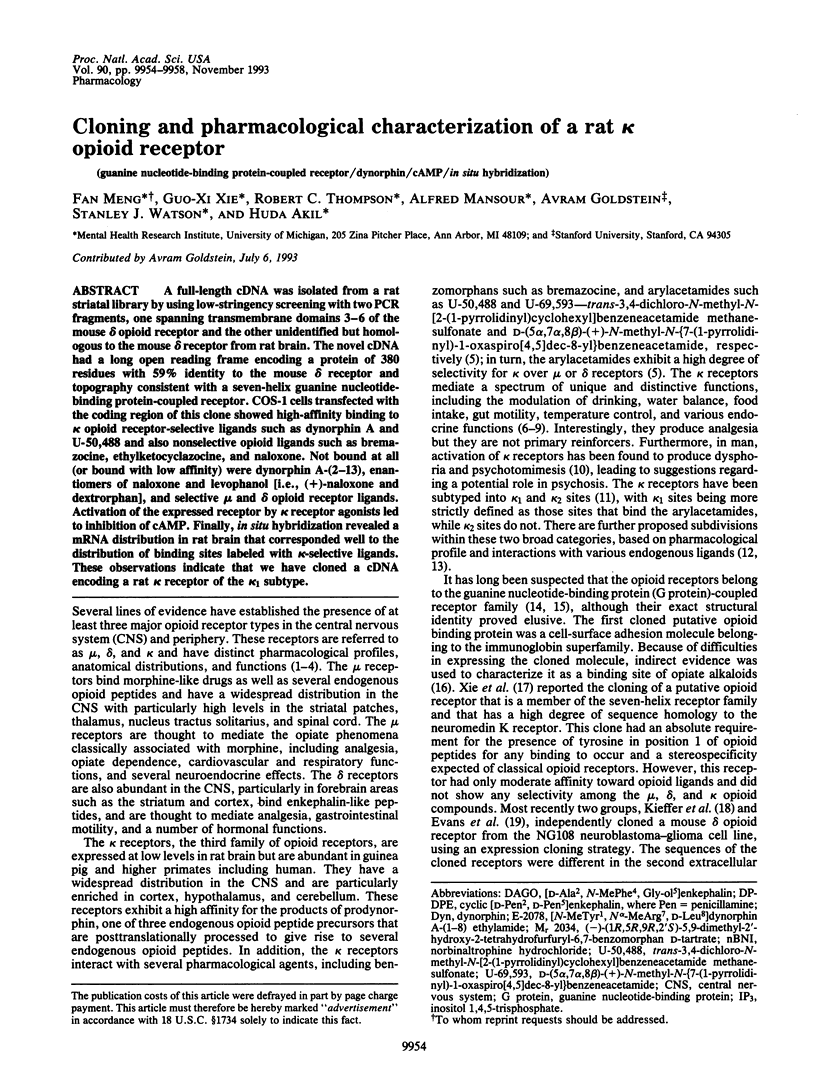
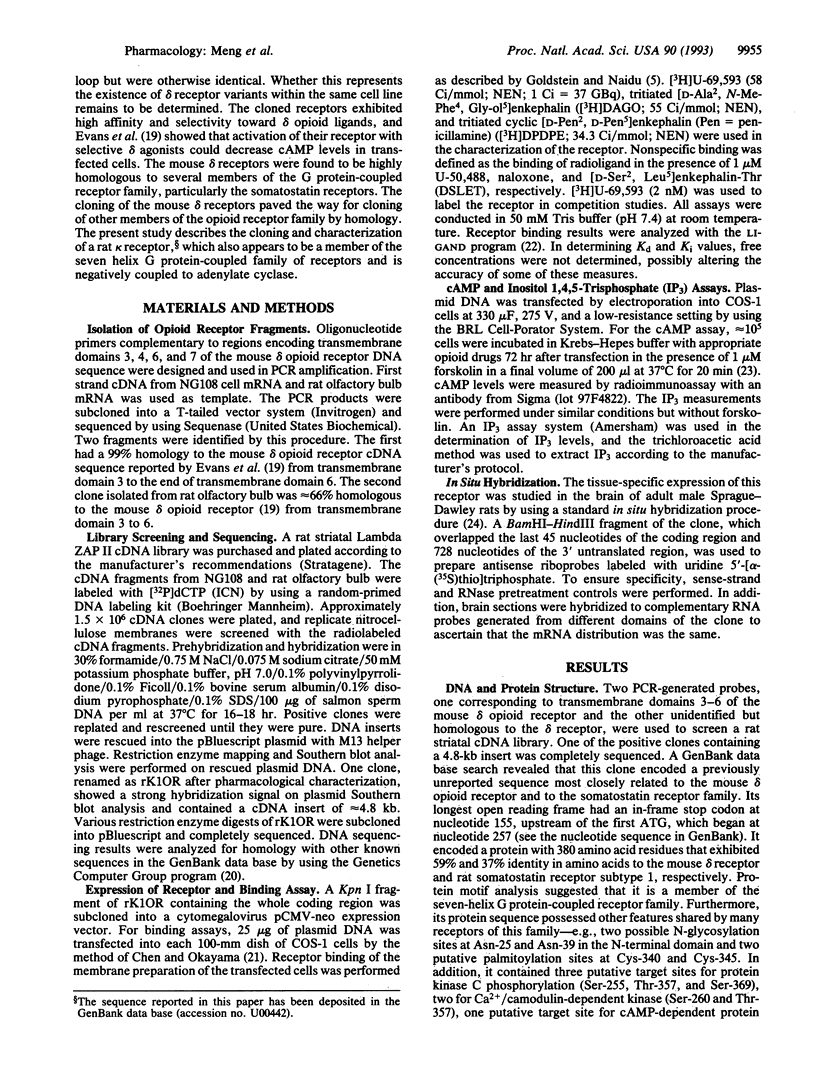
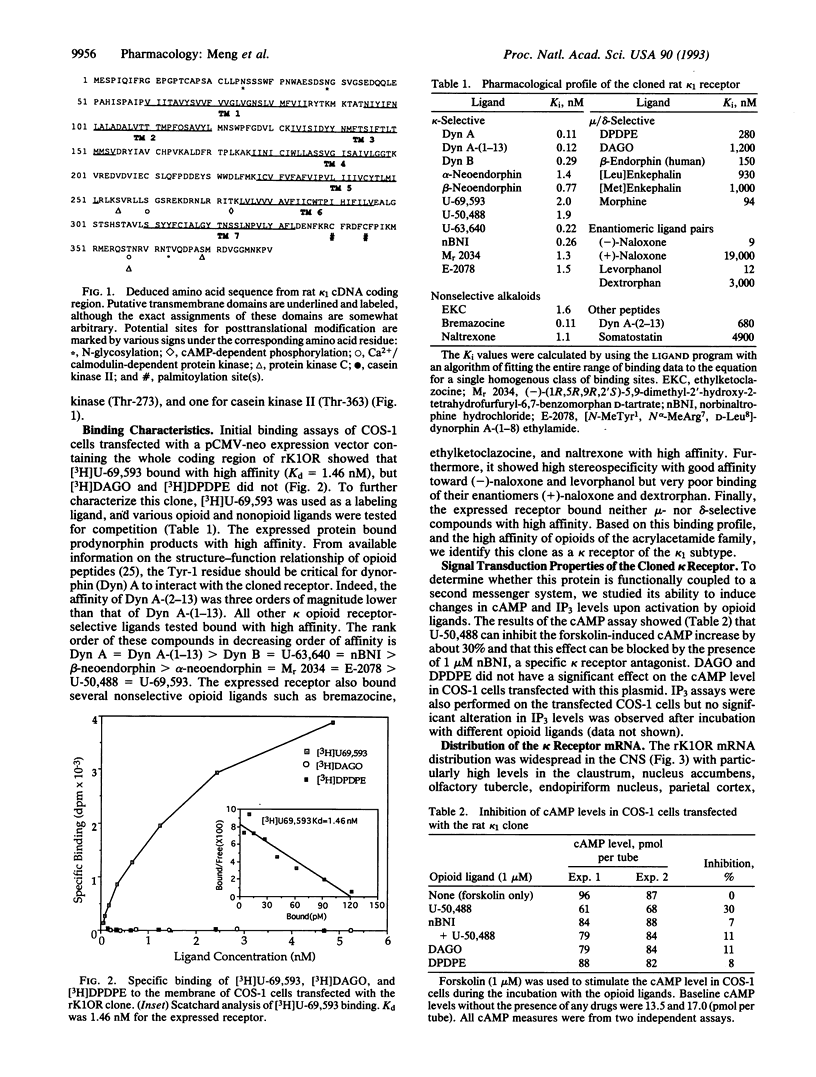
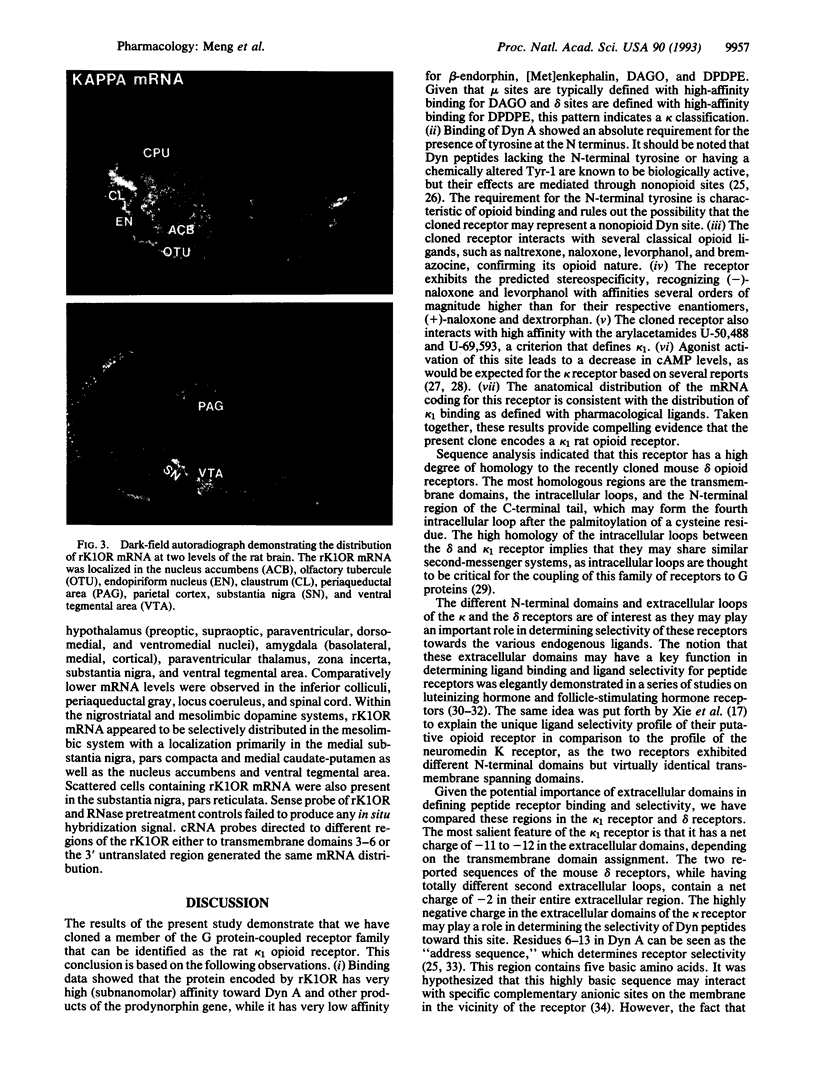
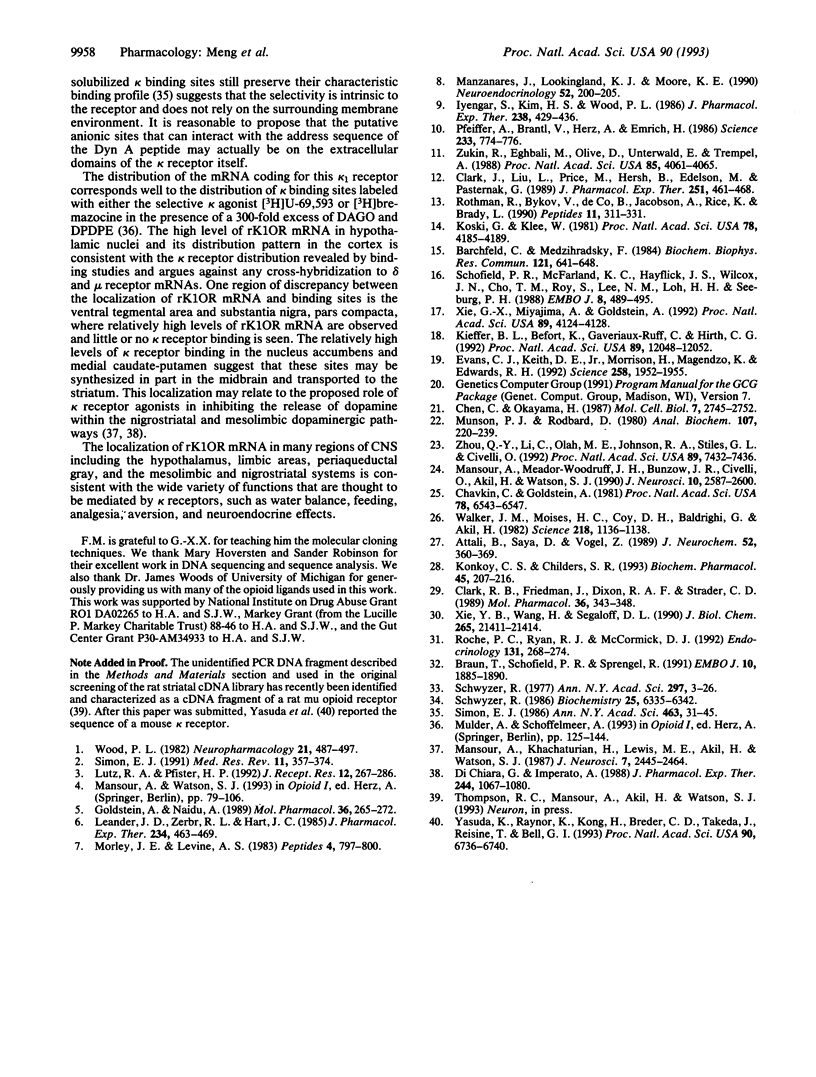
Images in this article
Selected References
These references are in PubMed. This may not be the complete list of references from this article.
- Attali B., Saya D., Vogel Z. Kappa-opiate agonists inhibit adenylate cyclase and produce heterologous desensitization in rat spinal cord. J Neurochem. 1989 Feb;52(2):360–369. doi: 10.1111/j.1471-4159.1989.tb09130.x. [DOI] [PubMed] [Google Scholar]
- Barchfeld C. C., Medzihradsky F. Receptor-mediated stimulation of brain GTPase by opiates in normal and dependent rats. Biochem Biophys Res Commun. 1984 Jun 15;121(2):641–648. doi: 10.1016/0006-291x(84)90230-4. [DOI] [PubMed] [Google Scholar]
- Braun T., Schofield P. R., Sprengel R. Amino-terminal leucine-rich repeats in gonadotropin receptors determine hormone selectivity. EMBO J. 1991 Jul;10(7):1885–1890. doi: 10.1002/j.1460-2075.1991.tb07714.x. [DOI] [PMC free article] [PubMed] [Google Scholar]
- Chavkin C., Goldstein A. Specific receptor for the opioid peptide dynorphin: structure--activity relationships. Proc Natl Acad Sci U S A. 1981 Oct;78(10):6543–6547. doi: 10.1073/pnas.78.10.6543. [DOI] [PMC free article] [PubMed] [Google Scholar]
- Chen C., Okayama H. High-efficiency transformation of mammalian cells by plasmid DNA. Mol Cell Biol. 1987 Aug;7(8):2745–2752. doi: 10.1128/mcb.7.8.2745. [DOI] [PMC free article] [PubMed] [Google Scholar]
- Clark J. A., Liu L., Price M., Hersh B., Edelson M., Pasternak G. W. Kappa opiate receptor multiplicity: evidence for two U50,488-sensitive kappa 1 subtypes and a novel kappa 3 subtype. J Pharmacol Exp Ther. 1989 Nov;251(2):461–468. [PubMed] [Google Scholar]
- Clark R. B., Friedman J., Dixon R. A., Strader C. D. Identification of a specific site required for rapid heterologous desensitization of the beta-adrenergic receptor by cAMP-dependent protein kinase. Mol Pharmacol. 1989 Sep;36(3):343–348. [PubMed] [Google Scholar]
- Di Chiara G., Imperato A. Opposite effects of mu and kappa opiate agonists on dopamine release in the nucleus accumbens and in the dorsal caudate of freely moving rats. J Pharmacol Exp Ther. 1988 Mar;244(3):1067–1080. [PubMed] [Google Scholar]
- Evans C. J., Keith D. E., Jr, Morrison H., Magendzo K., Edwards R. H. Cloning of a delta opioid receptor by functional expression. Science. 1992 Dec 18;258(5090):1952–1955. doi: 10.1126/science.1335167. [DOI] [PubMed] [Google Scholar]
- Goldstein A., Naidu A. Multiple opioid receptors: ligand selectivity profiles and binding site signatures. Mol Pharmacol. 1989 Aug;36(2):265–272. [PubMed] [Google Scholar]
- Iyengar S., Kim H. S., Wood P. L. Kappa opiate agonists modulate the hypothalamic-pituitary-adrenocortical axis in the rat. J Pharmacol Exp Ther. 1986 Aug;238(2):429–436. [PubMed] [Google Scholar]
- Kieffer B. L., Befort K., Gaveriaux-Ruff C., Hirth C. G. The delta-opioid receptor: isolation of a cDNA by expression cloning and pharmacological characterization. Proc Natl Acad Sci U S A. 1992 Dec 15;89(24):12048–12052. doi: 10.1073/pnas.89.24.12048. [DOI] [PMC free article] [PubMed] [Google Scholar]
- Konkoy C. S., Childers S. R. Relationship between kappa 1 opioid receptor binding and inhibition of adenylyl cyclase in guinea pig brain membranes. Biochem Pharmacol. 1993 Jan 7;45(1):207–216. doi: 10.1016/0006-2952(93)90394-c. [DOI] [PubMed] [Google Scholar]
- Koski G., Klee W. A. Opiates inhibit adenylate cyclase by stimulating GTP hydrolysis. Proc Natl Acad Sci U S A. 1981 Jul;78(7):4185–4189. doi: 10.1073/pnas.78.7.4185. [DOI] [PMC free article] [PubMed] [Google Scholar]
- Leander J. D., Zerbe R. L., Hart J. C. Diuresis and suppression of vasopressin by kappa opioids: comparison with mu and delta opioids and clonidine. J Pharmacol Exp Ther. 1985 Aug;234(2):463–469. [PubMed] [Google Scholar]
- Lutz R. A., Pfister H. P. Opioid receptors and their pharmacological profiles. J Recept Res. 1992;12(3):267–286. doi: 10.3109/10799899209074796. [DOI] [PubMed] [Google Scholar]
- Mansour A., Khachaturian H., Lewis M. E., Akil H., Watson S. J. Autoradiographic differentiation of mu, delta, and kappa opioid receptors in the rat forebrain and midbrain. J Neurosci. 1987 Aug;7(8):2445–2464. [PMC free article] [PubMed] [Google Scholar]
- Mansour A., Meador-Woodruff J. H., Bunzow J. R., Civelli O., Akil H., Watson S. J. Localization of dopamine D2 receptor mRNA and D1 and D2 receptor binding in the rat brain and pituitary: an in situ hybridization-receptor autoradiographic analysis. J Neurosci. 1990 Aug;10(8):2587–2600. doi: 10.1523/JNEUROSCI.10-08-02587.1990. [DOI] [PMC free article] [PubMed] [Google Scholar]
- Manzanares J., Lookingland K. J., Moore K. E. Kappa-opioid-receptor-mediated regulation of alpha-melanocyte-stimulating hormone secretion and tuberohypophyseal dopaminergic neuronal activity. Neuroendocrinology. 1990 Aug;52(2):200–205. doi: 10.1159/000125582. [DOI] [PubMed] [Google Scholar]
- Morley J. E., Levine A. S. Involvement of dynorphin and the kappa opioid receptor in feeding. Peptides. 1983 Nov-Dec;4(6):797–800. doi: 10.1016/0196-9781(83)90069-4. [DOI] [PubMed] [Google Scholar]
- Munson P. J., Rodbard D. Ligand: a versatile computerized approach for characterization of ligand-binding systems. Anal Biochem. 1980 Sep 1;107(1):220–239. doi: 10.1016/0003-2697(80)90515-1. [DOI] [PubMed] [Google Scholar]
- Pfeiffer A., Brantl V., Herz A., Emrich H. M. Psychotomimesis mediated by kappa opiate receptors. Science. 1986 Aug 15;233(4765):774–776. doi: 10.1126/science.3016896. [DOI] [PubMed] [Google Scholar]
- Roche P. C., Ryan R. J., McCormick D. J. Identification of hormone-binding regions of the luteinizing hormone/human chorionic gonadotropin receptor using synthetic peptides. Endocrinology. 1992 Jul;131(1):268–274. doi: 10.1210/endo.131.1.1612004. [DOI] [PubMed] [Google Scholar]
- Rothman R. B., Bykov V., de Costa B. R., Jacobson A. E., Rice K. C., Brady L. S. Interaction of endogenous opioid peptides and other drugs with four kappa opioid binding sites in guinea pig brain. Peptides. 1990 Mar-Apr;11(2):311–331. doi: 10.1016/0196-9781(90)90088-m. [DOI] [PubMed] [Google Scholar]
- Schofield P. R., McFarland K. C., Hayflick J. S., Wilcox J. N., Cho T. M., Roy S., Lee N. M., Loh H. H., Seeburg P. H. Molecular characterization of a new immunoglobulin superfamily protein with potential roles in opioid binding and cell contact. EMBO J. 1989 Feb;8(2):489–495. doi: 10.1002/j.1460-2075.1989.tb03402.x. [DOI] [PMC free article] [PubMed] [Google Scholar]
- Schwyzer R. ACTH: a short introductory review. Ann N Y Acad Sci. 1977 Oct 28;297:3–26. doi: 10.1111/j.1749-6632.1977.tb41843.x. [DOI] [PubMed] [Google Scholar]
- Schwyzer R. Molecular mechanism of opioid receptor selection. Biochemistry. 1986 Oct 7;25(20):6335–6342. doi: 10.1021/bi00368a075. [DOI] [PubMed] [Google Scholar]
- Simon E. J. Opioid receptors and endogenous opioid peptides. Med Res Rev. 1991 Jul;11(4):357–374. doi: 10.1002/med.2610110402. [DOI] [PubMed] [Google Scholar]
- Simon E. J. Recent studies on opioid receptors: heterogeneity and purification. Ann N Y Acad Sci. 1986;463:31–45. doi: 10.1111/j.1749-6632.1986.tb21501.x. [DOI] [PubMed] [Google Scholar]
- Walker J. M., Moises H. C., Coy D. H., Baldrighi G., Akil H. Nonopiate effects of dynorphin and des-Tyr-dynorphin. Science. 1982 Dec 10;218(4577):1136–1138. doi: 10.1126/science.6128791. [DOI] [PubMed] [Google Scholar]
- Wood P. L. Multiple opiate receptors: support for unique mu, delta and kappa sites. Neuropharmacology. 1982 Jun;21(6):487–497. doi: 10.1016/0028-3908(82)90038-7. [DOI] [PubMed] [Google Scholar]
- Xie G. X., Miyajima A., Goldstein A. Expression cloning of cDNA encoding a seven-helix receptor from human placenta with affinity for opioid ligands. Proc Natl Acad Sci U S A. 1992 May 1;89(9):4124–4128. doi: 10.1073/pnas.89.9.4124. [DOI] [PMC free article] [PubMed] [Google Scholar]
- Xie Y. B., Wang H., Segaloff D. L. Extracellular domain of lutropin/choriogonadotropin receptor expressed in transfected cells binds choriogonadotropin with high affinity. J Biol Chem. 1990 Dec 15;265(35):21411–21414. [PubMed] [Google Scholar]
- Yasuda K., Raynor K., Kong H., Breder C. D., Takeda J., Reisine T., Bell G. I. Cloning and functional comparison of kappa and delta opioid receptors from mouse brain. Proc Natl Acad Sci U S A. 1993 Jul 15;90(14):6736–6740. doi: 10.1073/pnas.90.14.6736. [DOI] [PMC free article] [PubMed] [Google Scholar]
- Zhou Q. Y., Li C., Olah M. E., Johnson R. A., Stiles G. L., Civelli O. Molecular cloning and characterization of an adenosine receptor: the A3 adenosine receptor. Proc Natl Acad Sci U S A. 1992 Aug 15;89(16):7432–7436. doi: 10.1073/pnas.89.16.7432. [DOI] [PMC free article] [PubMed] [Google Scholar]
- Zukin R. S., Eghbali M., Olive D., Unterwald E. M., Tempel A. Characterization and visualization of rat and guinea pig brain kappa opioid receptors: evidence for kappa 1 and kappa 2 opioid receptors. Proc Natl Acad Sci U S A. 1988 Jun;85(11):4061–4065. doi: 10.1073/pnas.85.11.4061. [DOI] [PMC free article] [PubMed] [Google Scholar]



